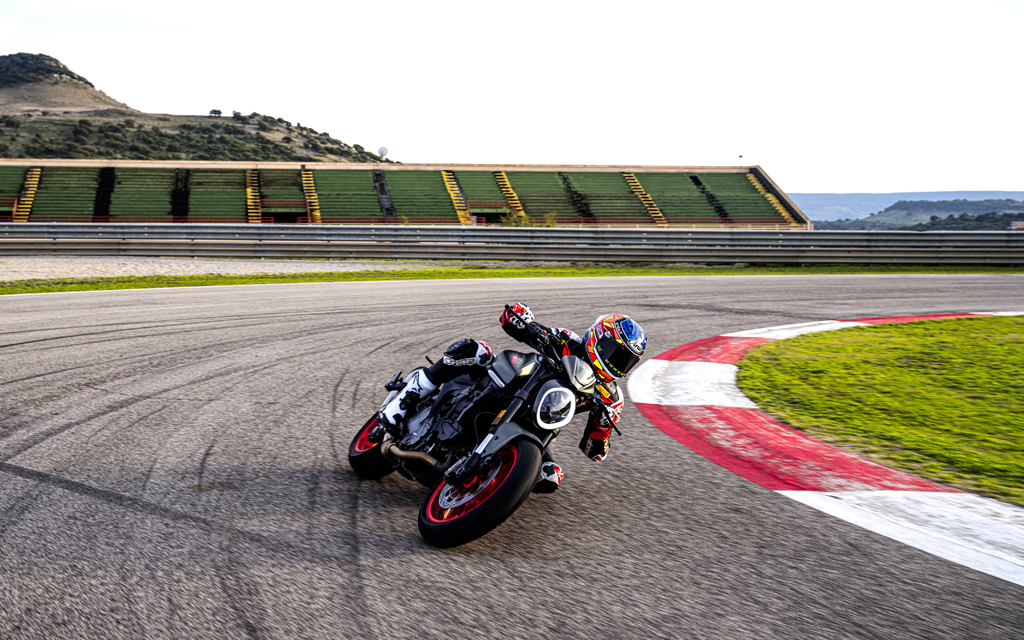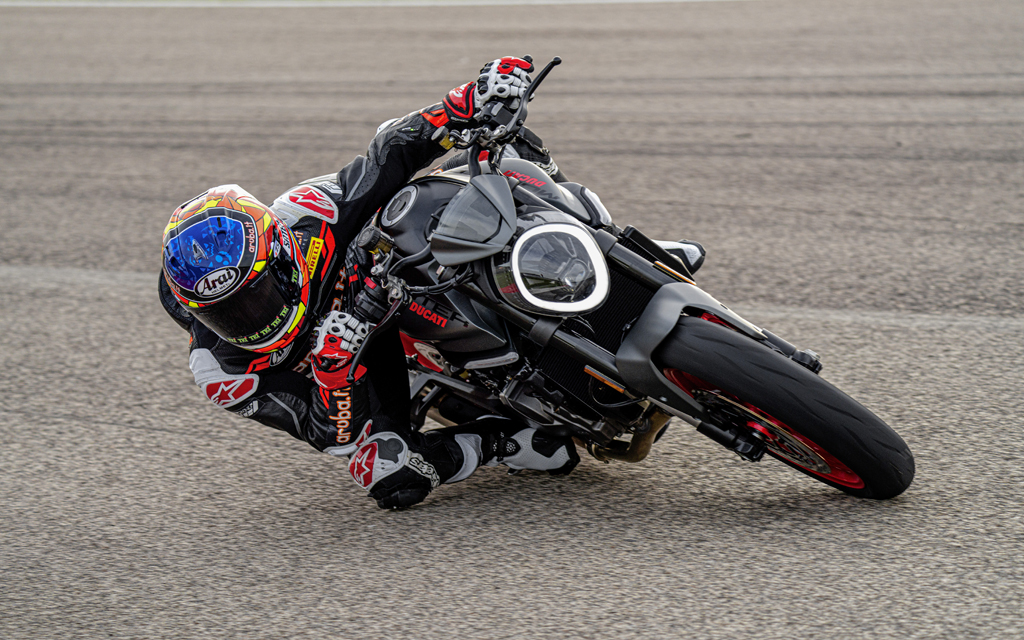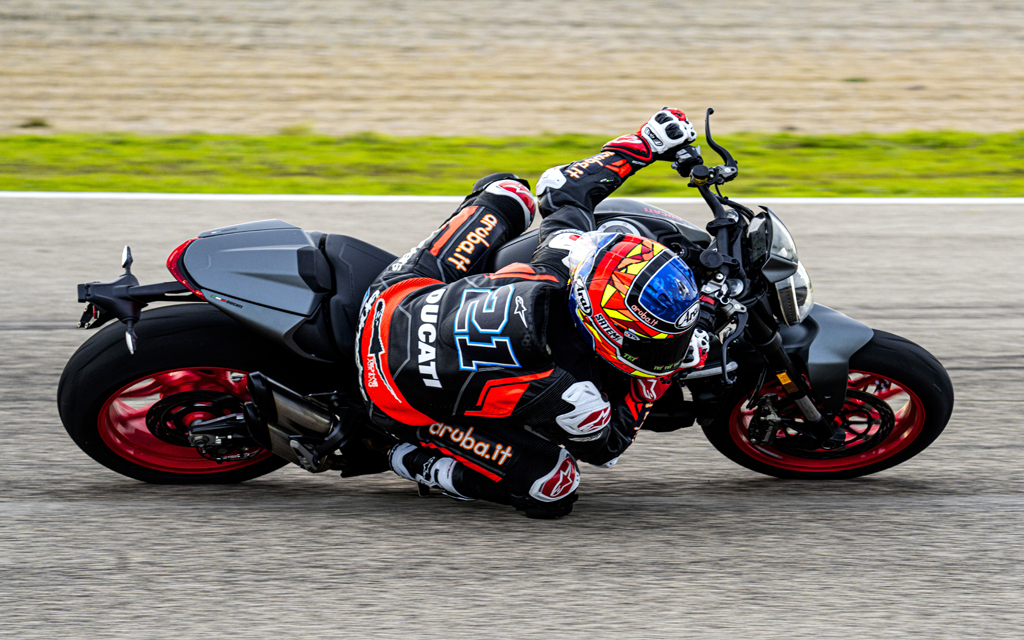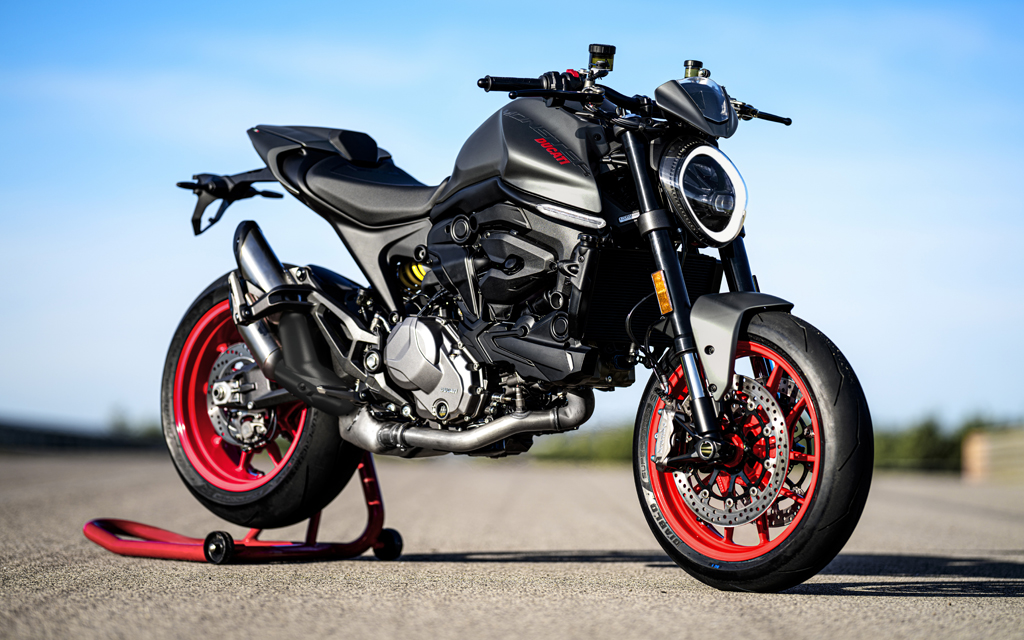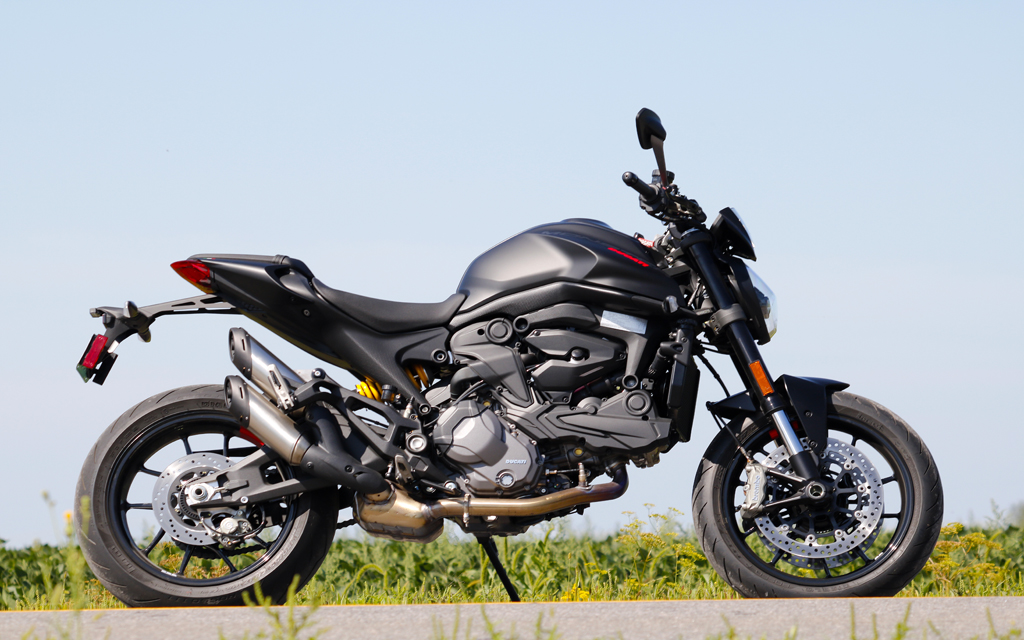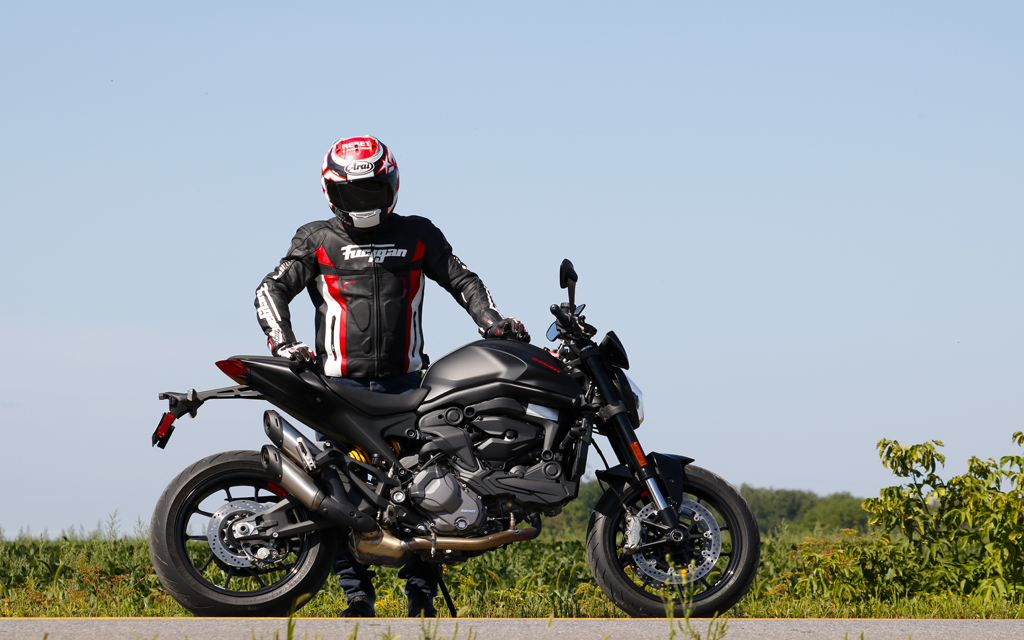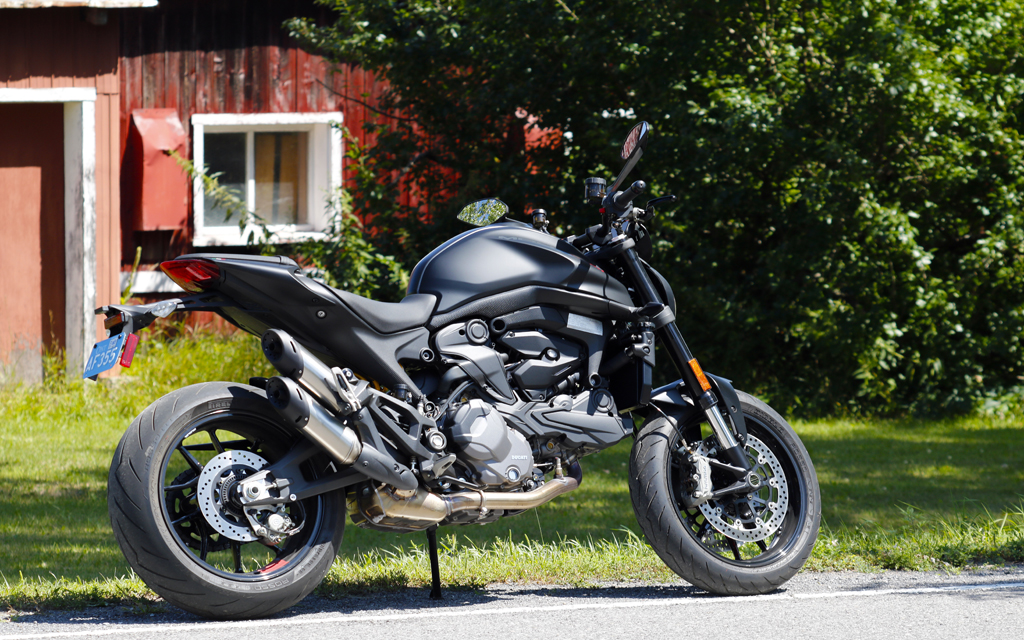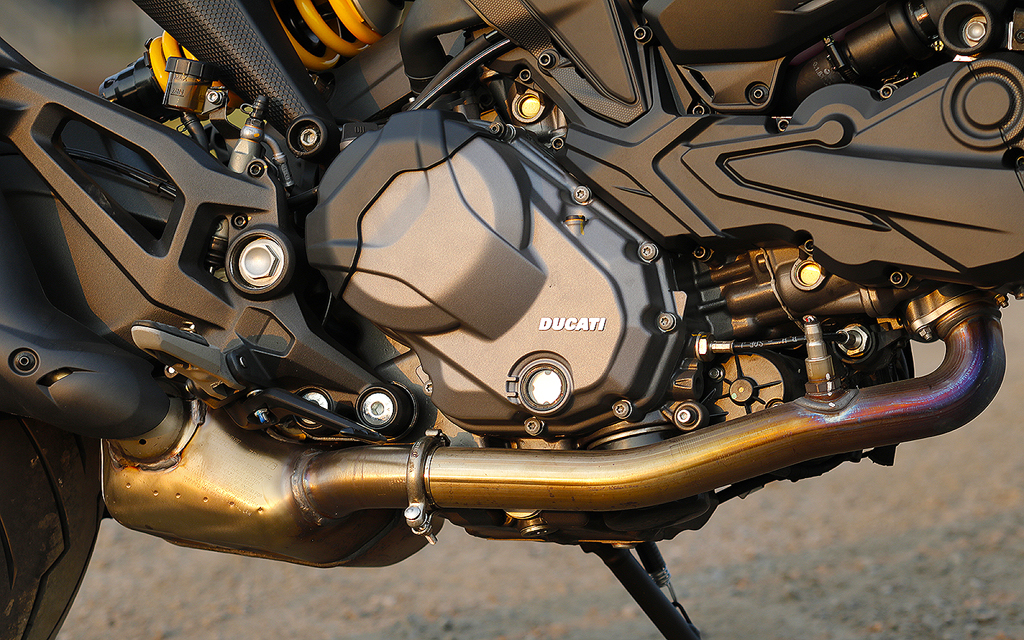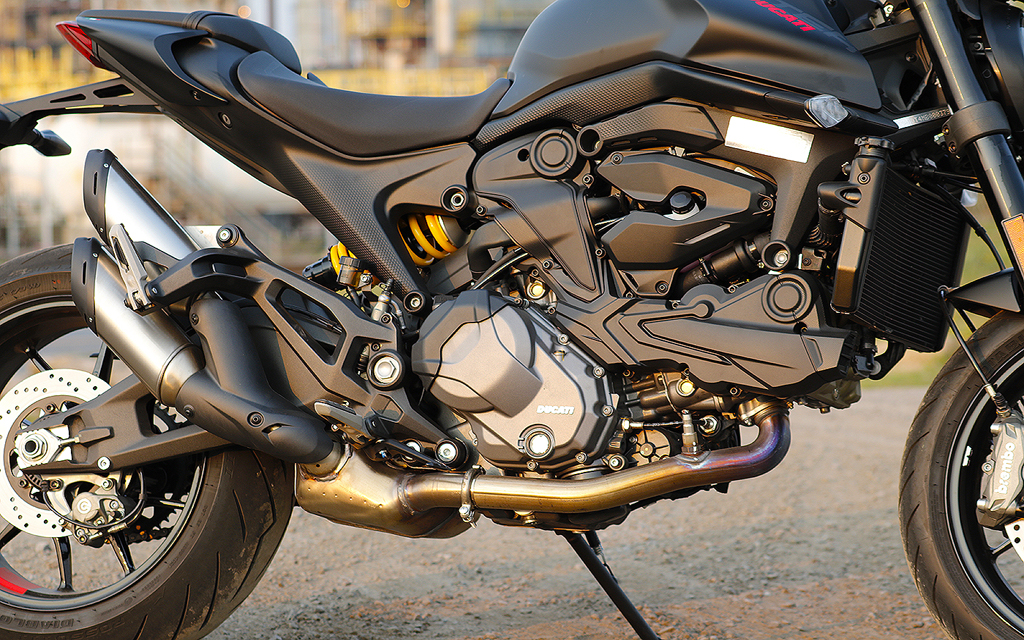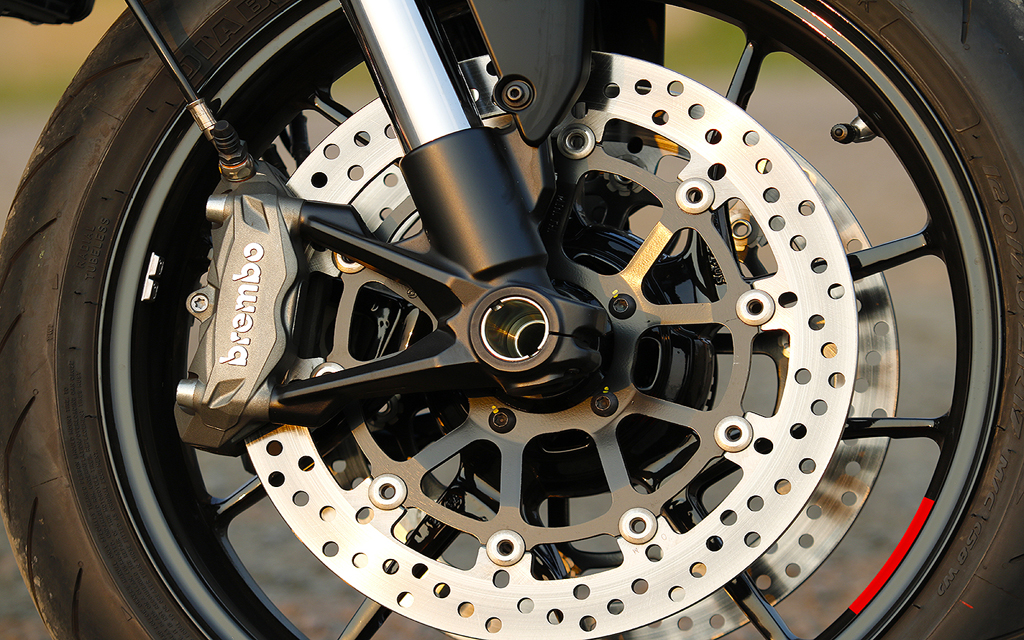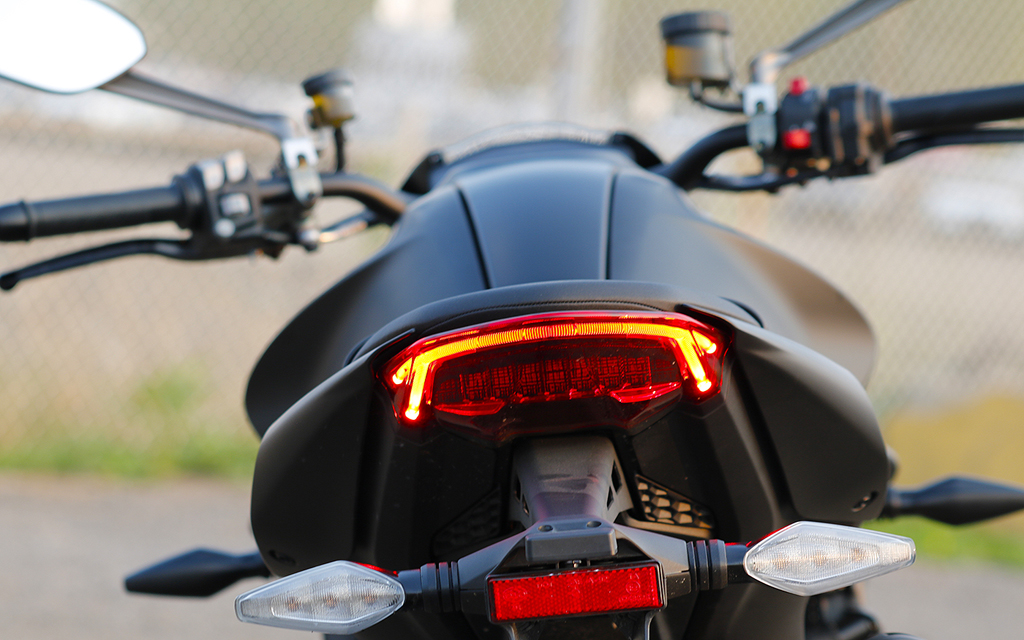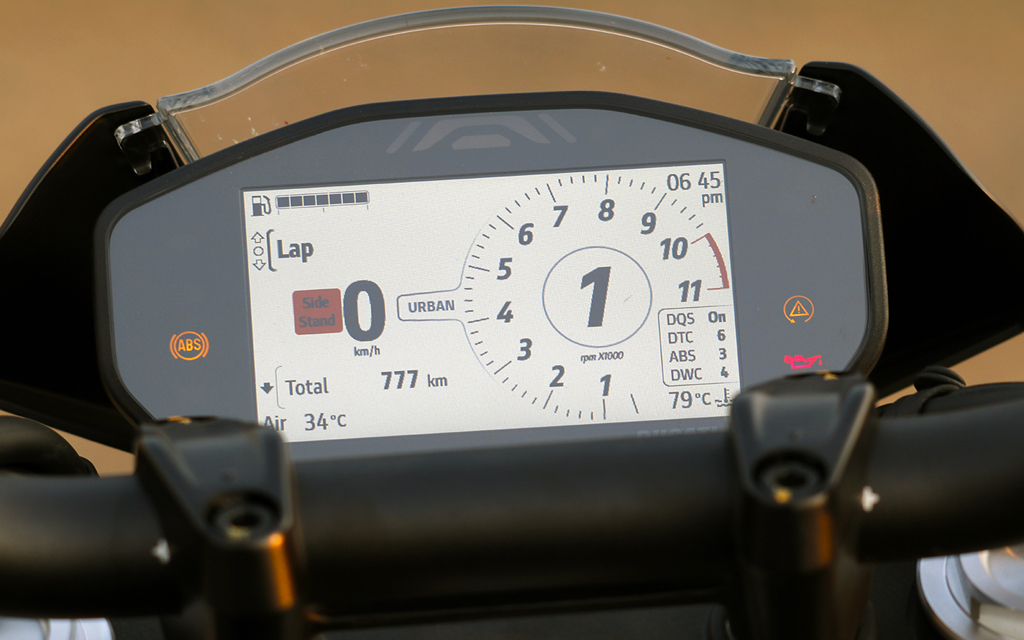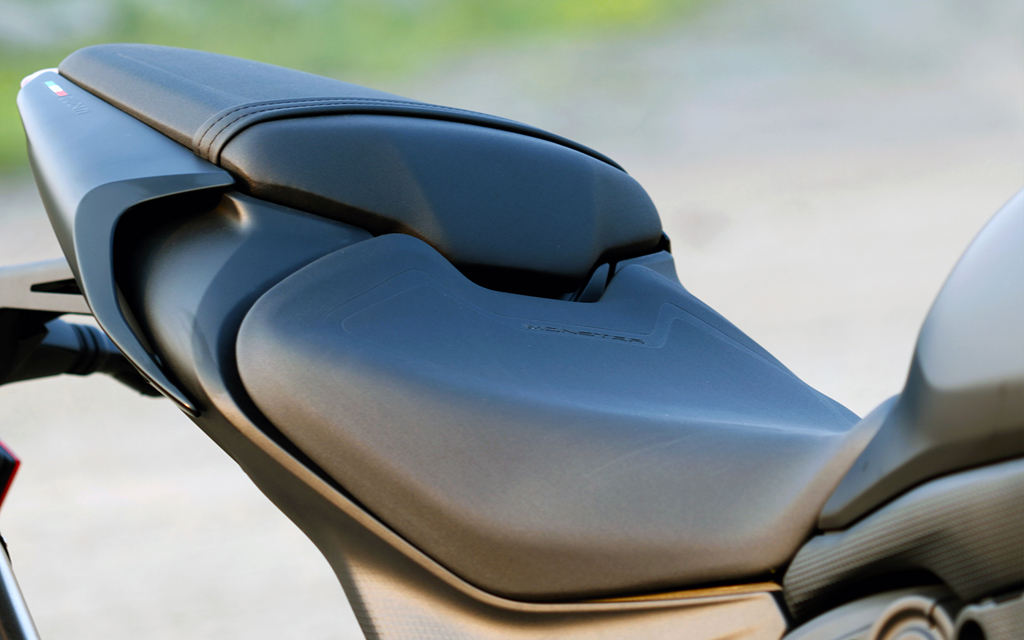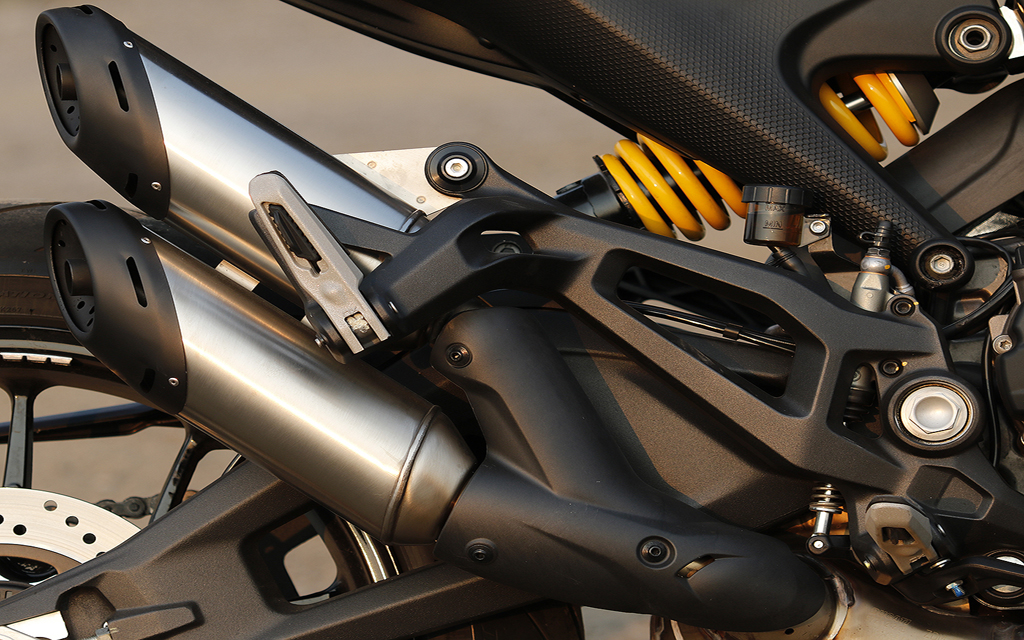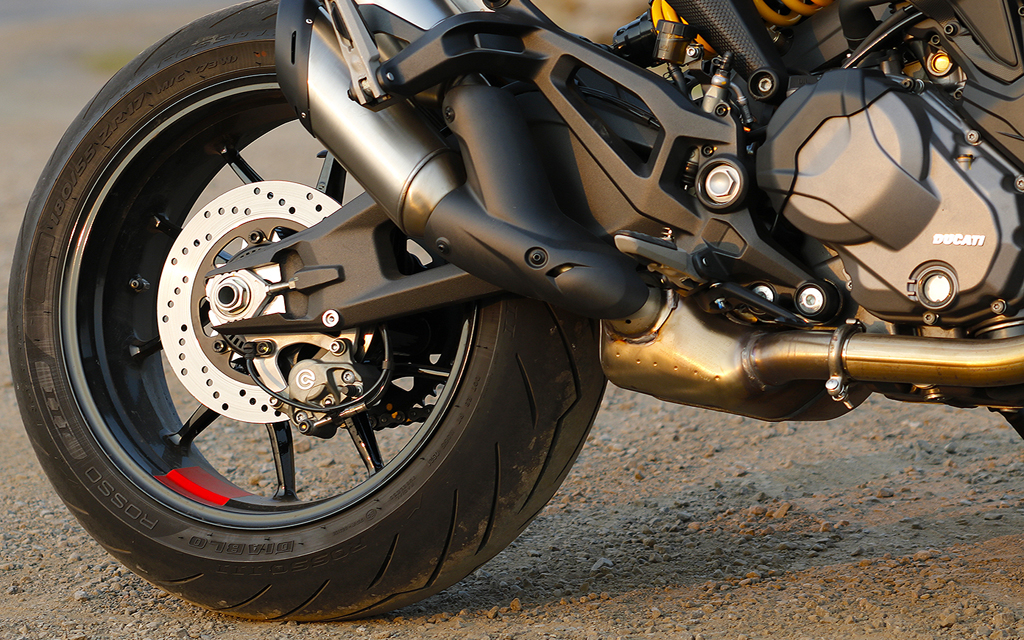Ducati has redefined its Monster line. There is only one model left and it no longer uses the historic design codes imposed by the 1993 original Mostro 900. The new Bologna monster is now a globalized product. Does that make it any better? That’s what I wanted to discover during this test.
Sacrilegio!
On the new and only Monster – the 1200R, 821 and 797 models are no longer part of the Italian manufacturer’s lineup – the iconic trellis frame, subsequently adopted by different other makers over the years, has been replaced with a monocoque frame, with the engine hung under and playing a structural role. What’s more, this frame is no longer red; its black finish makes it more similar to that of your everyday Japanese bike. And finally, the superb single-arm swingarm is replaced with a conventional swingarm that is certainly efficient, but less elegant and less distinctive. Less classy, too.
When these changes were made public, a silent rumble was heard throughout Italy, from Bologna to Bari. The Ducatisti were in discontent. For hardcore Ducati lovers, that was blasphemy, a case of lèse-majesté. Even treason!
Without taking Ducati’s defence, one has to recognize that the formerly very popular iconic Borgo Panigale roadster had not been selling that well anymore in the last few years. What’s more, the few tifosi still interested in a Monster did not know which one to choose. Now, with only one model left, their dilemma is resolved.
In reinventing the Monster, Ducati is certainly facing criticism, but the firm is also giving it a chance to rise from the ashes and start a new life.
New incarnation
Even with these transformations, the Monster still represents the very essence of Ducati by being as light, compact and quintessential as possible. The basic recipe is the same as the very first day: an athletic engine, finely tuned for road use, and a chassis derived from the Superbike. All things you need to have fun.
Personally, I think – though this may make purists scream – that Ducati took a calculated, but necessary risk by remodeling its Monster. The previous model was aging and it was becoming more and more complicated to go around the compromises imposed by its design. Plus, with its successive evolutions, it was becoming less and less efficient.
The Monster has a new uniformed style, with numerous plastic parts, that makes it look somewhat like a KTM Duke 890 (it uses the very same formula, essentially for the chassis), even like an Aprilia Tuono 660, or a MV Agusta Brutale 800 with its big flat oval headlight. The final result is a less distinctive style; the Monster now blends with the bulk of contemporary sports roadsters.
The chassis is built around a new two-part aluminum frame inspired by the Panigale V4. It is bolted to the engine and to a new fibreglass-reinforced polymer (GFRP) rear subframe. Weighing only 3 kg, this frame is 4.5 kg lighter than the previous trellis frame (a 60% reduction). All components also went through a weight-reduction process: the wheels lost 1.7 kg, the swingarm is 1.6 kg lighter and the rear subframe cuts another 1.9 kg thanks to the GFRP technology. Even the engine is lighter, by 2.4 kg, despite the extra displacement.
Hung under the frame, covered in part by carbon-fibre lookalike plastic panels, the engine is a stressed member of the chassis and it plays an important role to guarantee the structural rigidity of the bike. The powerplant is the Euro5 937 cc Testastretta 11° V-twin, borrowed to the Supersport, without desmodromic valve actuation. It has a modest 111 hp power output at 9,250 rpm, and a reasonable torque delivery of 69 lb-ft at 6,500 rpm. Nothing to get too excited about, you’ll agree, but these numbers are close to the Monster’s competitors, despite a superior displacement: Triumph Street Triple 765 RS (123 hp at 11,750 rpm, 58.3 lb-ft at 9,350 rpm), Yamaha MT-09 SP (119 hp at 10,000 rpm, 68.6 lb-ft at 7,000 rpm), KTM Duke 890 (115 hp at 9,000 rpm, 68 lb-ft at 8,000 rpm), Aprilia Tuono 660 (95 hp at 10,500 rpm, 49.4 lb-ft at 8,500 rpm). So, right amongst its peers!
Life on board
Visually, the Monster is a small-size bike. And that impression is confirmed when you sit on it. This is a light (188 kg wet) and compact bike. Wheelbase is relatively short (1,474 mm) and the steering geometry is on the sporty side (rake/trail: 24°/93 mm) which makes for a good manoeuvrability.
The riding position is a first for a Monster. The bars are around 70 mm closer to the pilot, the footpegs are 10 mm lower and 35 mm back. The torso is upright and slightly leaning forward; that position fits smaller pilots better than taller ones. With the new foot position, the legs are less tightly bent. All that make the bike easier to ride, even in urban traffic. Seat height is a reasonable 820 mm. And since the seat and gas tank are narrow where they join, the pilot can easily put both feet on the ground. An optional lower seat (800 mm) is also available, as well as lowering kit that takes the seat further down, to 775 mm.
My test bike was a Dark Stealth (black) Monster Plus with black rims, a small aerodynamic headlight fairing and a standard passenger seat hump.
The cockpit is simple and inviting. It features a 4.3 inch TFT screen with interface and graphics identical to those of the Supersport. The backlit screen is legible and modern. It even automatically goes in “night” mode in low-light conditions, and then back to “day” when needed.
That wide tubular handlebar is ideally shaped and the adjustable brake and clutch levers can be finely tuned with micrometric adjusters.
The mirrors allow you to easily see what’s happening behind. But at mid-revs at steady speed, they are affected by parasite vibrations that somewhat blur the images.
The sidestand extends way forward and you have to be careful to push it to its stop before stepping down from the motorcycle; otherwise, your machine may fall down, which does not look too good in public. Once deployed, the sidestand is also difficult to reach, especially for people with shorter legs, and it’s not easy to swing back up.
As for the electronic arsenal, the Monster is fitted with Ducati’s Safety Pack. It is equipped with a Ride-by-Wire throttle, a Bosch six-axis Inertial Measurement Unit that continuously monitors lean angles and mass transfers. It also includes cornering ABS (adjustable on three levels), traction control (eight levels, switchable), wheelie control (four levels, switchable), MotoGP style quick launch system (Ducati Launch Control) and an electronic quickshifter. Parameters adjustments, as well as driving modes (Sport, Touring, Urban), that can be fully customized by the user, are controlled through the interface of the new TFT screen. The menus are clear and intuitive (especially when you are used to Ducatis). However, a certain adaptation period is needed to easily manipulate the switches and levers on the left side of the handlebar.
The standard equipment also includes LED lights, a USB outlet under the seat and a storage compartment, also under the seat, that allows you to stuff a disc lock or a small tightly rolled rain jacket. The Ducati Multimedia system is offered as an option.
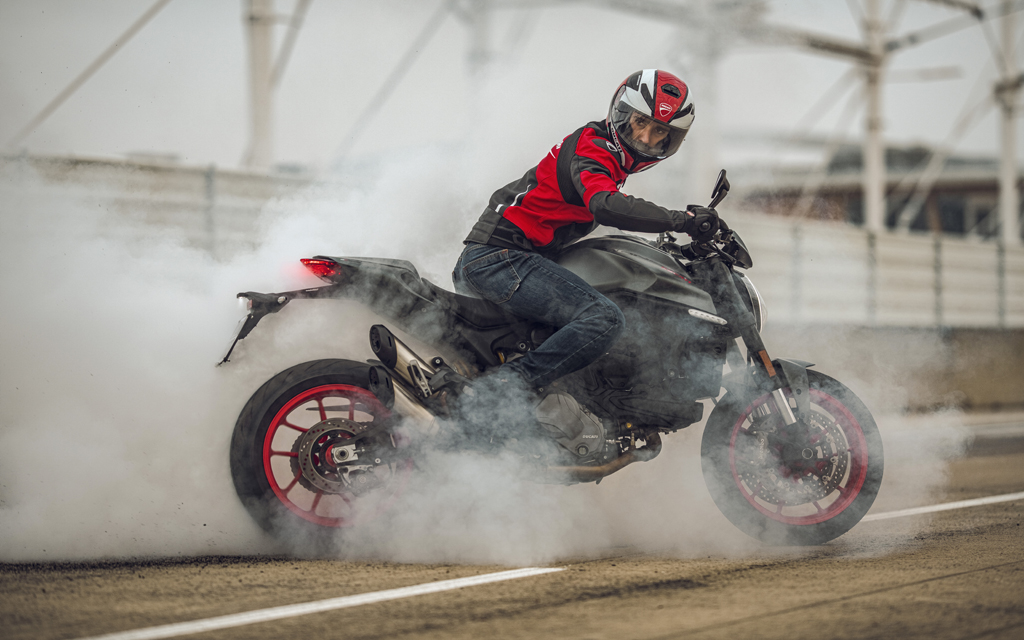
On the road
Despite all these changes, the Monster still keeps most of its characteristic traits, some fine, some less so. For example, the engine is still as noisy, especially when cold, though the clutch is now up to Japanese standards and the transmission is precise and silent. It does not snap like the previous one and it is complemented with a quickshifter that’s precise and efficient most of the time. Clutch action is smooth and progressive.
Gearing is still too tall for no reason and the V-2 still lacks flexibility under 3,000 rpm, where it knocks furiously. No fun for city driving.
But in its comfort zone, between 3,000 and 9,000 rpm, the Monster is a delight to ride. The torque is ubiquitous and the engine is lively and full of character. Accelerations are crisp, and going up the revs creates a rich deep exhaust note, complemented by the growl from the airbox. You can take the engine up to its redline in each gear, at 10,000 rpm, but it’s no use going over that point. On the highway, in sixth gear, the twin is geared a little short; it spins a little over 5,000 rpm at 130 km/h.
Too bad the engine radiates so much heat, especially in city driving where it rapidly becomes unbearable. On hot summer days, it’s a torture.
The big difference with the previous model, especially in city driving and in tight spots, is the turning radius. This Monster can make tight turns like no Monster ever did. We had been waiting for this for 28 years. Doing a U-turn and putting your feet back on the ground in one single maneuver has never been that easy. Finally!
On secondary roads, the Monster’s improved nimbleness and manoeuvrability make it easy to put on angle. In twisties, it flies from one curve to another, and the front stays superbly anchored to the ground, thanks to the fine Pirelli Diablo Rosso III tires that deliver exceptional grip. The front end is particularly confidence-inspiring for a pilot who wants to push the Ducati close to its limits. As for the rear tire, it also delivers an almost faultless tractability.
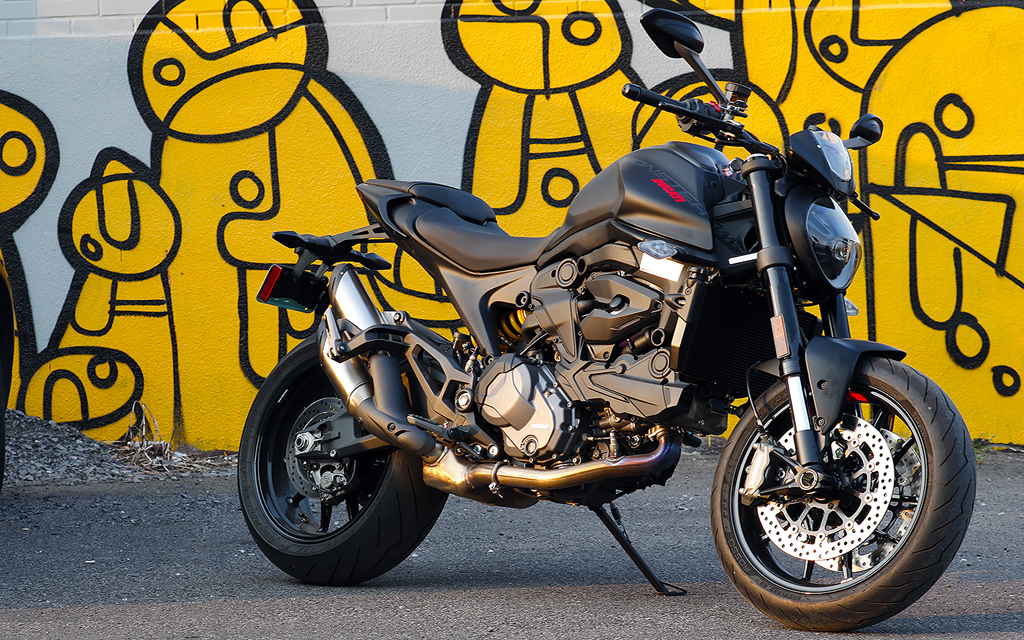
It’s in long wide-open curves that the monocoque chassis best shows its benefits. It is hyper stable and demands a lot less effort from the pilot to deliver its full potential. The monster is on a rail and it does not deviate from its trajectory. Imperial! The mass centralization and unsprung weight reduction radically transform the dynamic behaviour of the Monster.
The Kayaba suspension (non-adjustable 43 mm fork, preload adjustable shock) is harsh, but still generally efficient despite its apparent simplicity. The suspension is tuned for versatility rather than for full-sports potential. The monocoque chassis perfectly does its job and works in perfect harmony with the suspension. On secondary roads, you can adopt a sporty rhythm with no fear at all. For a more intense use, on a racetrack for example, higher specs fully-adjustable components would be recommended, even if the pictures of official WSBK pilot Michael Ruben Rinaldi included in the press kit demonstrate that it’s easy to exploit the full potential of the Monster… when you have the talent and driving skills needed. Track Day riders will certainly appreciate the Monster, especially if they only do it occasionally. For the fun of it.
I had set up a Track Day at the Mécaglisse track in order to evaluate the sports skills of the Monster, but the weather conditions did not cooperate. And since I had the bike for only a few days, it was not possible to rebook later. That will be for next season. I took a raincheck.
The Brembo front brake with radial master cylinder, M4.32 calipers and 320 mm discs is top-notch. It’s powerful, easy to modulate and sends a good feedback to the pilot, so he always stays in total control. The rear brake is slightly less upscale, but it does help place the bike on angle and maintain a fine balance. ABS is transparent and unintrusive.
On fast roads and highways, the limited protection offered by the Monster still restricts its touring potential. And the headlight fairing doesn’t change much to the picture. Up to 130 km/h, the air pressure is tolerable, but at higher speeds, it’s on the upper torso and helmet. The firm seat also put a limitation on long rides, especially on highways where you essentially stay still on the motorcycle.
For the complaint department, let’s mention the lightness of the front end on uneven road surfaces – a steering damper would be welcome – , a reduced fuel range resulting from the smaller gas tank, the difficult navigation through menus while riding – the nerds will adapt quickly, others will be annoyed for sure – , the engine’s lack of flexibility at low revs, and the heat generated in traffic. Besides that, the Monster can be described as essentially flawless.
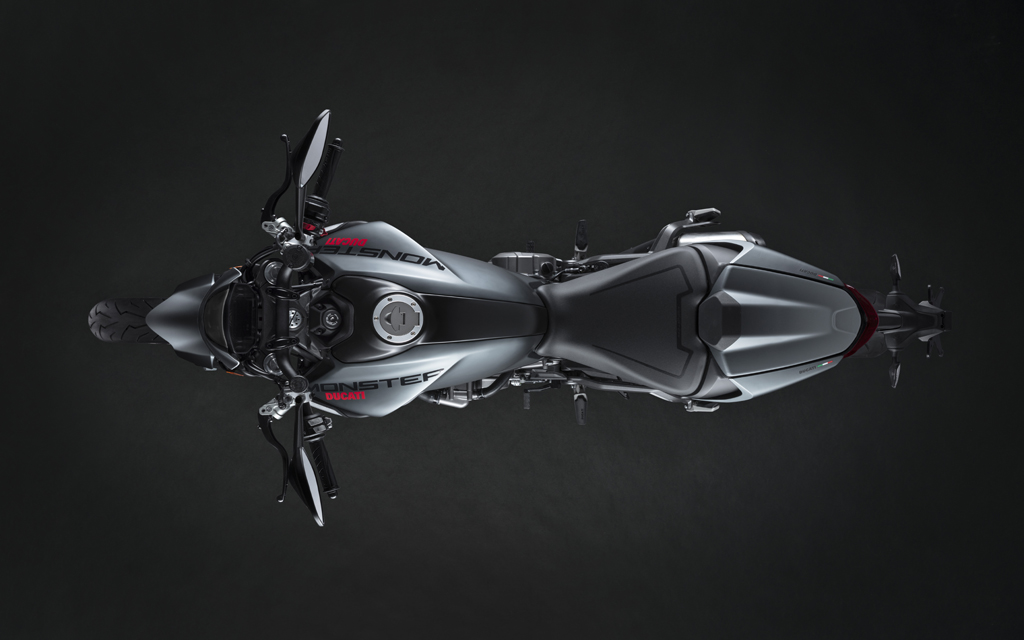
Wrap-up
Even if some tifosi will be displeased, the new look of the Monster, and most importantly the changes to its chassis, transform the Bologna roadster. It is now a light, nimble, stable and playful machine that shows all its potential on small twisty roads. The driving position is almost ideal, between that of a supermoto like the KTM 890 Duke and the more relaxed position of the Yamaha MT-09. Its reduced weight (18 kg less) makes it even more rebel, if not delinquent. In reality, the Monster is almost head to head with the Austrian and the Japanese in terms of sports driving, while delivering better driving sensations. The Italian is precise, stable and very maneuverable. Plus, with its bigger displacement engine, it delivers strong torque and a solid response at all revs. With more flexibility at low revs and less heat reaching the pilot, it would be close to perfection.
With a turning radius that makes it much more user-friendly than before, the Monster is more fun to ride in urban environments and on secondary roads where you often have to make impromptu U-turns. From a somewhat trucklike behaviour, it is almost transformed into a ballet dancer. In other words, the mutation is a success. And too bad for traditions! Personally, I am seduced and reconciled with the Bologna roadster.
The Monster is available in three colour combinations: Ducati red, Dark Stealth with black wheels, and Aviator grey with red GP wheels. It is offered at $13,795. For those who want a sportier model, a Plus version is also offered, with the same colour schemes, for $14,195.
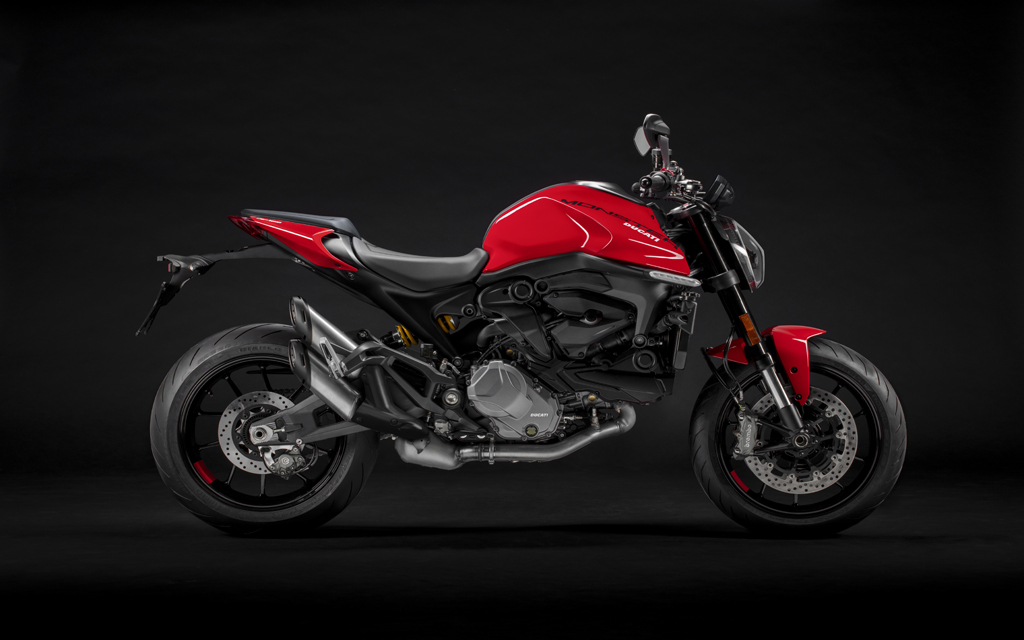
SPECIFICATIONS
GENERAL DATA
Wet weight: 188 kg
Seat height: 820 mm
Fuel capacity: 14 L
Fuel consumption: 5.6 L/100 km
Fuel range: around 250 km
Test duration: 400 km
Colours: grey, back, red
Price: $14,195
ENGINE
Engine type: Testastretta 11°, V-TWIN 4-stroke, desmodromic valve actuation, liquid-cooled, 4-valve per cylinder, Euro5
Maximum power: 111 hp at 9,250 rpm
Maximum torque: 69 lb-ft at 6,500 rpm
Displacement: 937 cc
Bore x stroke: 94 x 67.5 mm
Compression ratio: 13.3:1
Carburation: electronic injection, 53 mm throttle body with Ride-by-Wire
Transmission: 6-speed, DQS quickshifter standard
Final drive: chain
CHASSIS
Suspension: inverted 43 mm fork, non-adjustable; progressive linkage monoshock, adjustable preload and damping
Wheelbase: 1,474 mm
Rake/trail: 24°/93 mm
Brakes: two 320 mm discs, Brembo M4-32 4-piston calipers; single 245 mm disc, Brembo 2-piston caliper, cornering Bosch ABS
Tires: Pirelli Diablo Rosso III
120/70 -17 front
180/55-17 rear
